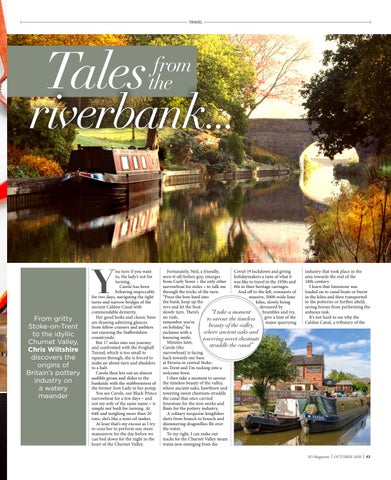Travel
Y From gritty Stoke-on-Trent to the idyllic Churnet Valley, Chris Wiltshire discovers the origins of Britain’s pottery industry on a watery meander
ou turn if you want to, the lady’s not for turning. Carole has been behaving impeccably for two days, navigating the tight turns and narrow bridges of the ancient Caldon Canal with commendable dexterity. Her good looks and classic lines are drawing admiring glances from fellow cruisers and amblers out enjoying the Staffordshire countryside. But 17 miles into our journey and confronted with the Froghall Tunnel, which is too small to squeeze through, she is forced to make an about-turn and shudders to a halt. Carole then lets out an almost audible groan and slides to the bankside with the stubbornness of the former Iron Lady in her pomp. You see Carole, our Black Prince narrowboat for a few days – and not my wife of the same name – is simply not built for turning. At 64ft and weighing more than 20 tons, she’s like a mini oil tanker. At least that’s my excuse as I try to coax her to perform one more manoeuvre for the day before we can bed down for the night in the heart of the Churnet Valley.
Fortunately, Neil, a friendly, Covid-19 lockdown and giving seen-it-all-before guy, emerges holidaymakers a taste of what it from Curly Sioux – the only other was like to travel in the 1950s and narrowboat for miles – to talk me 60s in their heritage carriages. through the tricks of the turn. And off to the left, remnants of “Press the bow hard into massive, 500ft-wide lime the bank, keep up the kilns, slowly being revs and let the boat devoured by slowly turn. There’s brambles and ivy, “I take a moment no rush, give a hint of the to savour the timeless remember you’re major quarrying beauty of the valley, on holiday,” he exclaims with a where ancient oaks and knowing smile. towering sweet chestnuts Minutes later, straddle the canal” Carole (the narrowboat) is facing back towards our base at Etruria in central Stokeon-Trent and I’m tucking into a welcome brew. I then take a moment to savour the timeless beauty of the valley, where ancient oaks, hawthorn and towering sweet chestnuts straddle the canal that once carried limestone for the iron works and flints for the pottery industry. A solitary turquoise kingfisher darts from branch to branch and shimmering dragonflies flit over the water. To my right, I can make out tracks for the Churnet Valley steam trains now emerging from the
industry that took place in the area towards the end of the 18th century. I learn that limestone was loaded on to canal boats or burnt in the kilns and then transported to the potteries or further afield, saving horses from performing the arduous task. It’s not hard to see why the Caldon Canal, a tributary of the
SO Magazine | October 2020 | 43















